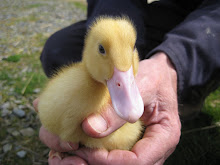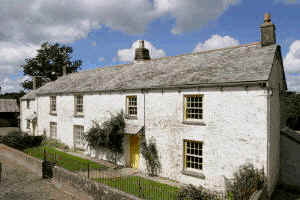 The farm is strangely shaped along the lines of a miniature South America, with the house on the eastern coast of Brazil, a bit of river frontage on the west coast of Ecuador and a mill leat across the top of Venezuela. Accordingly, and not much changed since medieval farmers were doing their thing, the field boundaries are all shapes and trying to describe where you will be is not as simple as saying 3 along and 2 up. The naming of fields feels like an exercise not to be undertaken lightly, and maintaining the historical names if they can be extracted seems appropriate for somewhere that has been around for so long. Even so, I suspect names change every few generations. Last weekend we walked the farm with someone who had grown up here and he knew names for all but three of the fields. So we have Big Stone Horse Field and it's neighbour, Little Stone Horse Field, both stoney and where the horses were kept. Then there is Pretty Field, so called because it has a regular shape. Big Furze Down and Lower Furze Down are the names for the two fields that had been covered in gorse before they were ploughed up for arable purposes; gorse still flowers in patches in the hedgerows and creates a very prickly and effective sheep fence. Long Lands was probably named for the fact that although not large (none of the fields are very big), it is a fair uphill walk to reach the end. Higher Down and Lower Down sound like a joke but they do what they say on the tin, and Big Oaky and Little Oaky have a few fairly spectacular oaks in the hedgelines. Bull's field was where the bull was kept with his cows, and so on it goes. Having only to take responsibility for a limited number, we have named the nameless fields. One is now Mopsa's Meadow and another Fenn's Field. Nice to think that long after the dogs have gone their field names will survive. And yup - that's South America, not the farm!
The farm is strangely shaped along the lines of a miniature South America, with the house on the eastern coast of Brazil, a bit of river frontage on the west coast of Ecuador and a mill leat across the top of Venezuela. Accordingly, and not much changed since medieval farmers were doing their thing, the field boundaries are all shapes and trying to describe where you will be is not as simple as saying 3 along and 2 up. The naming of fields feels like an exercise not to be undertaken lightly, and maintaining the historical names if they can be extracted seems appropriate for somewhere that has been around for so long. Even so, I suspect names change every few generations. Last weekend we walked the farm with someone who had grown up here and he knew names for all but three of the fields. So we have Big Stone Horse Field and it's neighbour, Little Stone Horse Field, both stoney and where the horses were kept. Then there is Pretty Field, so called because it has a regular shape. Big Furze Down and Lower Furze Down are the names for the two fields that had been covered in gorse before they were ploughed up for arable purposes; gorse still flowers in patches in the hedgerows and creates a very prickly and effective sheep fence. Long Lands was probably named for the fact that although not large (none of the fields are very big), it is a fair uphill walk to reach the end. Higher Down and Lower Down sound like a joke but they do what they say on the tin, and Big Oaky and Little Oaky have a few fairly spectacular oaks in the hedgelines. Bull's field was where the bull was kept with his cows, and so on it goes. Having only to take responsibility for a limited number, we have named the nameless fields. One is now Mopsa's Meadow and another Fenn's Field. Nice to think that long after the dogs have gone their field names will survive. And yup - that's South America, not the farm!
Tuesday, 21 February 2006
Today we have naming of fields
 The farm is strangely shaped along the lines of a miniature South America, with the house on the eastern coast of Brazil, a bit of river frontage on the west coast of Ecuador and a mill leat across the top of Venezuela. Accordingly, and not much changed since medieval farmers were doing their thing, the field boundaries are all shapes and trying to describe where you will be is not as simple as saying 3 along and 2 up. The naming of fields feels like an exercise not to be undertaken lightly, and maintaining the historical names if they can be extracted seems appropriate for somewhere that has been around for so long. Even so, I suspect names change every few generations. Last weekend we walked the farm with someone who had grown up here and he knew names for all but three of the fields. So we have Big Stone Horse Field and it's neighbour, Little Stone Horse Field, both stoney and where the horses were kept. Then there is Pretty Field, so called because it has a regular shape. Big Furze Down and Lower Furze Down are the names for the two fields that had been covered in gorse before they were ploughed up for arable purposes; gorse still flowers in patches in the hedgerows and creates a very prickly and effective sheep fence. Long Lands was probably named for the fact that although not large (none of the fields are very big), it is a fair uphill walk to reach the end. Higher Down and Lower Down sound like a joke but they do what they say on the tin, and Big Oaky and Little Oaky have a few fairly spectacular oaks in the hedgelines. Bull's field was where the bull was kept with his cows, and so on it goes. Having only to take responsibility for a limited number, we have named the nameless fields. One is now Mopsa's Meadow and another Fenn's Field. Nice to think that long after the dogs have gone their field names will survive. And yup - that's South America, not the farm!
The farm is strangely shaped along the lines of a miniature South America, with the house on the eastern coast of Brazil, a bit of river frontage on the west coast of Ecuador and a mill leat across the top of Venezuela. Accordingly, and not much changed since medieval farmers were doing their thing, the field boundaries are all shapes and trying to describe where you will be is not as simple as saying 3 along and 2 up. The naming of fields feels like an exercise not to be undertaken lightly, and maintaining the historical names if they can be extracted seems appropriate for somewhere that has been around for so long. Even so, I suspect names change every few generations. Last weekend we walked the farm with someone who had grown up here and he knew names for all but three of the fields. So we have Big Stone Horse Field and it's neighbour, Little Stone Horse Field, both stoney and where the horses were kept. Then there is Pretty Field, so called because it has a regular shape. Big Furze Down and Lower Furze Down are the names for the two fields that had been covered in gorse before they were ploughed up for arable purposes; gorse still flowers in patches in the hedgerows and creates a very prickly and effective sheep fence. Long Lands was probably named for the fact that although not large (none of the fields are very big), it is a fair uphill walk to reach the end. Higher Down and Lower Down sound like a joke but they do what they say on the tin, and Big Oaky and Little Oaky have a few fairly spectacular oaks in the hedgelines. Bull's field was where the bull was kept with his cows, and so on it goes. Having only to take responsibility for a limited number, we have named the nameless fields. One is now Mopsa's Meadow and another Fenn's Field. Nice to think that long after the dogs have gone their field names will survive. And yup - that's South America, not the farm!
Subscribe to:
Post Comments (Atom)

















No comments:
Post a Comment